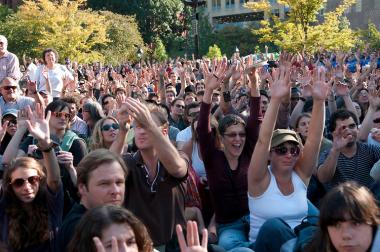
As a visually impaired person, I wanted to take part in the Occupy movement as soon as I heard about it in 2011. I was able to talk my boyfriend into marching with me on November 18 in downtown Pittsburgh, despite his fears of being arrested. We walked and chanted through the Cultural District, ending up in People’s Park at 6th and Grant early that afternoon. Sharing a blanketed spot on the muddy ground with long-time Pittsburgh activist Vincent Scotti Eirene, the fabled human microphone was activated.
That night people were setting up tents in the cold November winter and I remember thinking, “This is no place for a blind girl to sleep.” but I had to find a way to be part of it all.
Determined to Occupy, despite my inability to “camp,” I began to search for a virtual general assembly platform so that those of us (and there were many) who could not be “on the ground” might take part on a level playing field.
My adapted computer made it possible to navigate the web and I began a long, test-drive, journey involving MaestroConferences (shout out to Nate Kleinman for tekking those InterOccupy calls), Google Hangouts and Mumble meetings which although allowed us to feel closer to the action, left so much to be desired in terms of reaching the holy grail of the Occupy movement: consensus.
I joined a number of NYCGA groups and a couple of Facebook pages, cross posting sometimes (I am so sorry, but it seemed urgent at the time) seeking a virtual, real time, platform-agnostic tool that would allow individuals to work through issues and make well-informed decisions together.
Many people were working on such things and a list was started to keep track of them thanks to Micah Daigle and his Facebook page Upgrade Democracy. Open Assembly (Frank Posthuman Imperative) was the first viable solution I found. This was November 2011; Frank’s project was in its infancy and the task, though noble, somehow seemed out of reach.
Undaunted, my Occupy efforts turned to helping establish a directory of encampments…if we weren’t going to be able to hold virtual, General Assemblies en masse, we could at least make it easy find one another! So I joined forces with a group of dedicated Drupal coders who were working across the globe to create the Occupy directory. The Guardian published The Occupy map of the world on the one year anniversary of Occupy Wall Street, September 17, 2012.
Today, occupations are no longer defined by location, and one’s physical presence is not an essential part of participation, but the need to collectively work through issues and reach agreement is more urgent than ever.
On March 10 of this year Micah posted “The World Needs a Better Way to Make Decisions. Let’s Build It!” on Upgrade Democracy. I was thrilled to see Loomio, an open source, gift economy, fully functioning, multilingual, decision making tool created by members of Occupy New Zealand.
After viewing the YouTube demos and reading about their successful application in Greece, I found myself daydreaming of what Loomio could have done for our movement in 2011...how differently the General Assemblies would have been run if decisions had been facilitated using Loomio. Or what if NYCGA had used it before implementing the dreaded Spokes council?
Loomio encourages people to talk things through in a virtual environment by allowing people to start a discussion on any topic, bring information to the table and invite others into engage in discourse. Building agreement is a process achieved by sharing diverse perspectives and developing ideas together.
True to Occupy’s original custom, anyone can propose a course of action. People can agree, abstain, disagree, or block – during the process...so you can see how everyone feels, and why.
All participants propose, develop and agree together so that ultimately the agreement works for everyone. Each decision has a clear deadline, so outcomes are understood and predictable. After all, consensus is something everyone can live with as opposed something in which everyone wins.
I remember when we were working on the directory, we didn’t know what would become of our efforts, that’s the way I feel about Loomio. I’m not sure precisely how it will change the game, but I know that it will.
In my quest for a virtual decision making tool, I had a wish list... that the solution be easy, safe, accessible and platform agnostic. Loomio is designed to be as easy to use as email. Setting up and running your own independent version is simple so privacy is entirely under your own control. Most importantly the solution needed to be accessible; to include people of varied ability levels.
The crowdfunding campaign—which wraps up five days from this writing—will provide the time and resources the core team needs to focus on Loomio full time through November, at which point they will incorporate user experience improvements, full email integration, a lightweight mobile interface, multilingual and accessibility support bringing collaborate decision making to people across the spectrum of access and ability.
The idea that each person should have their voice heard has always been a linchpin of the Occupy movement, in my opinion Loomio allows for this to become a reality.
Learn more about Loomio here.

